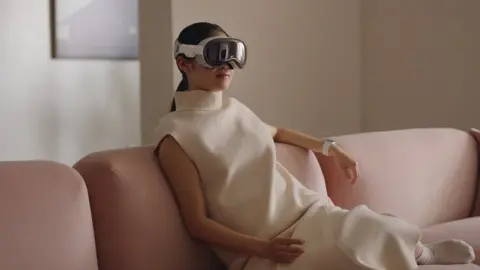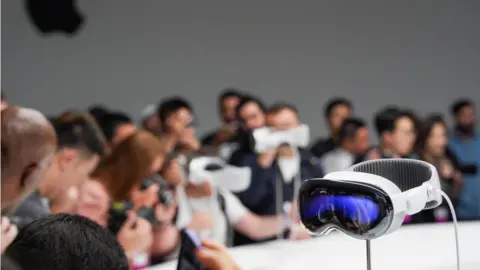BBC editor tries out Apple's $3,499 headset
 APPLE
APPLEThe first thing you notice about Apple's Vision Pro headset is that it's fairly comfortable - as much as wearing a pair of giant ski goggles on your face can possibly be.
I was one of the first people in the world to try out the hugely anticipated, and very expensive, new mixed-reality headset, following its launch in California on Monday.
Unlike many existing headsets, Apple has detached the battery, so it doesn't sit heavy on your head - although it does mean the battery has to sit beside you instead, tethered by a cable.
The user experience is classic, minimalist Apple. Once the headset is on, you see the room around you but you're not seeing it through glass, you're seeing it through the many on-board cameras. This is important for the "mixed-reality" experience - digital content projected onto your surroundings.
You physically press a single button on the top right-hand side of glasses, and up pops some familiar app icons you'll recognise if you have used an iPhone - iMessage, photos, Apple TV (there will be more as developers make them).
And from then on it's all about gesture control - the headset tracks where you are looking so when you look at an app and pinch your thumb and forefinger together, it opens.
 Getty Images
Getty ImagesApple swept me through a number of demos. A gallery of photos, stretching from floor to ceiling, were impressive to see - although these were clearly very carefully curated, and very beautifully shot.
You can shoot 3D video using the cameras on the headset - I watched a child blow out birthday candles on a cake so close to me that I felt I could almost feel her breath.
I had a live video call with another Apple employee, also wearing a headset - well, a photorealistic avatar of him rather than an actual video. I don't know what he really looked like because I never met him in real life but there was something a bit weird about the smoothness of his skin, and the detail of his eyes, even when he smiled and frowned.
I watched movie clips on a giant virtual screen with the room digitally darkened around me like a cinema theatre. A gigantic 3D T. rex dinosaur sniffed my face. I watched digital flower petals dance around the room during a mindfulness meditation.
You can choose your level of immersion using a physical dial to turn up or down the size of whatever it is that you're looking at. It can fill the entire room or appear like a TV screen superimposed against your wall.
If someone walks in front of you in real life, you can see them no matter how immersed you are.
 Getty Images
Getty ImagesI had a laborious go at trying to respond to a text message on the digital keyboard that popped up in front of me. "Remember this is not a finished product!" was the enthused response every time I said something that was less than glowing.
Unfortunately, I can't show you any of this because everyone there was banned from recording anything. Noticeably, nobody from Apple actually wore a Vision Pro either - not even the boss, Tim Cook, or Disney CEO, Bob Iger, who described the device as "real-life magic".
I've tried a lot of virtual-reality (VR) and mixed-reality headsets in my time as a tech journalist and this was one of the better ones. And with a launch price tag of $3,499 (£2,899) you'd hope so.
It will probably still be the most-expensive headset on the market when it goes on sale next year. Bloomberg has reported that Apple hopes to shift 900,000 in the first year of sales.
So who is going to buy it?
I think Apple is playing a very clever game here with its marketing - although I'm not sure whether it will work. Traditionally, mixed-reality headsets have been targeted at gamers and promised big, extravagant moments. Kill monsters the size of your house! Be a rock star on stage at Wembley Stadium!
Apple barely mentioned gaming at all. The message here was much more: do everything you do on your phone, only bigger and brighter and against the backdrop of your own home.
There was much speculation that the Apple Vision Pro announcement would be an "iPhone moment" - that is, a huge, game-changing product from Apple in the way the iPhone changed the smartphone landscape forever.
But what if the Apple Vision Pro actually is the new iPhone?
By making it a useful bit of every day kit rather than an occasional thrill, Apple is very much aiming this at the mainstream.
I'm not sure whether it will work. Apple has a unique magic and a very loyal customer base. People who like the brand really, really like the brand. But hardware has long been a barrier in VR.
Wearing a headset for long periods of time just does not feel great. Plenty of people experience nausea (I do too, although I didn't on Monday - my demo was only 15 minutes long though, with a couple of minutes on each section).
How much of it is novelty?
I can tell you with certainty that while it was a remarkable experience, I'm not sure I want to be sniffed by a virtual dinosaur again any time soon.
Now clearly $3,499 is not a novelty product price. I remember wincing last year when Facebook-owner Meta announced its Quest Pro headset would cost about $1,500, less than half the price (it has since fallen to $999).
You are of course paying for the years of research and development that goes into building the first generation of any product. But what if you use it every day?
A friend of mine who works in the fashion industry says you should spend the most money on the clothes you wear most often.
So if you spend £100 on a dress and wear it once, that single wear was £100. But if you wear it 100 times - it's only cost you £1 each time.
Perhaps Apple is gambling that if it can make the headset useful enough, people are more likely to think about it that way. It needs a lot of content, and a lot of developers to make that work.
But if you like Apple, and you like mixed reality, and you have the cash - you'll probably like this headset.
If in five years time it's replaced your smartphone - well, perhaps our avatars can virtually FaceTime each other and have a chat about it.
Follow Zoe on Twitter.
